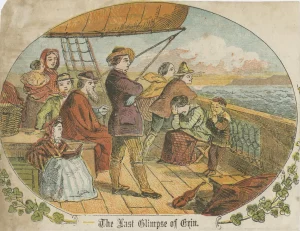In Rot: A History of the Irish Famine, Padraic X. Scanlan offers a searing and meticulously researched account of one of the most devastating events in Irish history. Rather than presenting the famine as a tragic act of nature, Scanlan traces its roots to political negligence, colonial policy, and systemic exploitation under British rule. Through vivid storytelling and sharp analysis, Rot challenges long-held narratives and exposes the slow, deliberate rot at the heart of imperial governance during Ireland’s darkest years.

Writing from exile in eastern Tennessee during the late 1850s, Irish nationalist John Mitchel used his proslavery publication, The Southern Citizen, to unleash a scathing critique of British policy during the Great Famine. In 1861, these writings were reissued under the title The Last Conquest of Ireland (Perhaps)—a fierce indictment that would galvanize generations of nationalists. Mitchel famously concluded that “a million and a half men, women, and children were carefully, prudently, and peacefully slain by the English government,” having perished amid abundance, victims of a heartless adherence to the tenets of political economy.
Mitchel’s legacy lingers—though largely uncredited—in Padraic X. Scanlan’s Rot: A History of the Irish Famine, a sharply argued and engagingly written account that reframes the catastrophe through the lens of British capitalism and colonialism. For Scanlan, the famine was not merely the result of a potato blight but the culmination of centuries of extractive systems that had left Ireland socially brittle and economically dependent. British demand for grain and livestock, he argues, twisted Irish agriculture into a model that made subsistence on potatoes the only viable option for the rural poor. What appeared backward was, in Scanlan’s phrasing, “heartbreakingly, almost quintessentially, modern.”
The book draws on an established body of Irish historiography that highlights Britain’s economic and political role in shaping the asymmetries between the two islands. Early chapters explore how depictions of Irish peasants as lazy, uncivilized, and fundamentally different from the British mainstream were used to justify their exploitation. The image of the Irish as mere “potato-eaters” (“potatophagi”) was emblematic of these stereotypes—portrayed not as victims of structural injustice but as obstinate refusers of “civilization.” Scanlan even interrogates the widely cited claim that Irish laborers consumed 14 pounds of potatoes daily, suggesting it functioned more as symbolic propaganda than nutritional reality—a racialized metric meant to affirm British superiority.
As the narrative shifts to state responses during the Famine, Scanlan underscores how British policy was driven less by malice than by ideological rigidity. Across political lines—Whigs, Conservatives, and Liberals alike—relief efforts were shaped by a Victorian belief in market discipline. “Charity,” if not linked to labor, was seen as dangerous, potentially undermining the moral improvement markets were presumed to instill. Thus, even Robert Peel’s import of American corn is reframed not as compassionate intervention but as a maneuver to reinforce free trade and wean the Irish off potatoes, creating new commercial opportunities for British grain.
This reading significantly challenges the conventional portrayal of Peel’s efforts as humanitarian and decisive. While Peel could not have foreseen the return of the blight in 1846, Scanlan maintains that Parliament’s policies operated under the assumption that little was at stake for British interests regardless of Ireland’s fate.
Rot is compelling in its clarity and narrative force. Scanlan skillfully weaves together a broad range of sources, making his book accessible and impactful for general readers. Yet the power of his central thesis can at times flatten the complex realities it seeks to illuminate. For instance, Scanlan overlooks the similarities between Irish and English social policy—particularly the 1838 Irish Poor Law, modeled on the English Poor Law of 1834, which enshrined the notorious workhouse system. This alignment complicates the binary of colonial domination and suggests that prevailing attitudes toward poverty and moral worth were shared across the British Isles, not just imposed on Ireland alone.
Moreover, in emphasizing colonial logic, Rot sometimes casts the Irish as passive sufferers, undermining their roles as agents navigating—and at times resisting—oppression. In doing so, the book reverts to a narrative that more recent scholarship has worked hard to nuance and challenge.
Despite these limitations, Rot is an urgent and provocative work that invites readers to reconsider the Famine not as a tragic accident, but as a product of deliberate systems. It may not break new ground for specialists, but for a wider audience, it provides a powerful, if sometimes simplified, retelling of one of Ireland’s darkest chapters.
